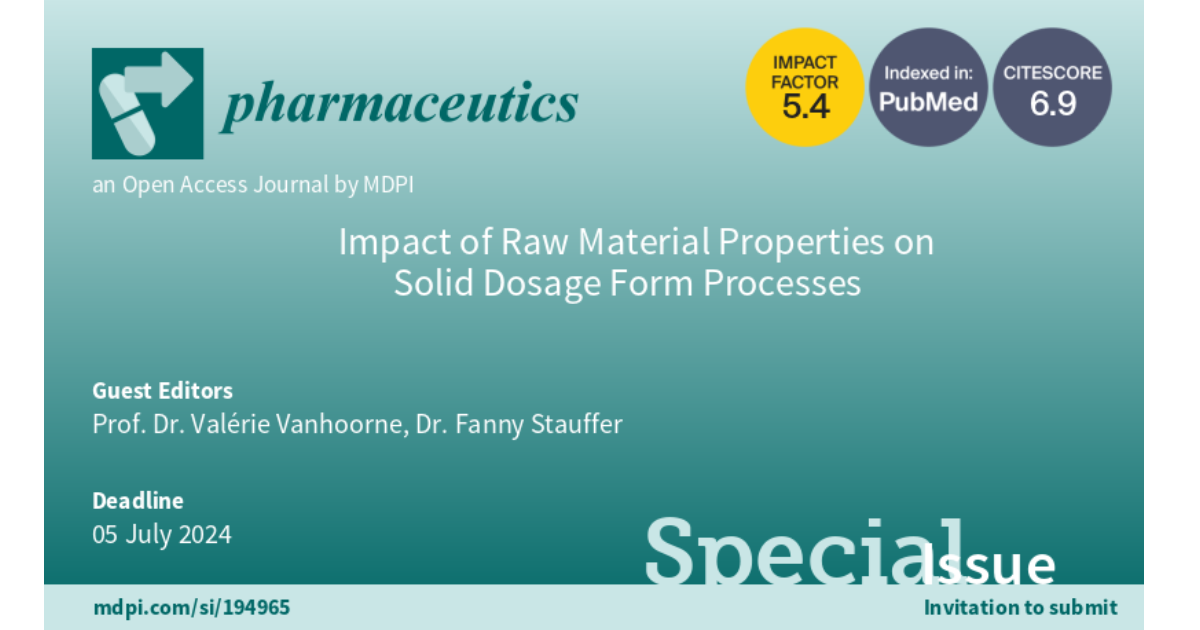Impact of Raw Material Properties on Solid Dosage Form Processes
A special issue of Pharmaceutics (ISSN 1999-4923). This special issue belongs to the section "Physical Pharmacy and Formulation".
Deadline for manuscript submissions: 5 July 2024 | Viewed by 1466

Special Issue Editors
Interests: pharmaceutical technology; continuous manufacturing; 3D printing; additive manufacturing; pellets; twin-screw granulation; direct compression; material science
Special Issues, Collections and Topics in MDPI journals
Special Issue Information
Dear Colleagues,
The interlink between raw material properties and drug product performance has been a growing research topic in the last few years. Advances in the definition of a manufacturing classification system allowed rationalizing drug product process selection based on raw material properties. Such initiatives, however, rely on powder characterizations predictive of the behaviour of the powder during manufacturing at the pilot or commercial scale. It also implies that the raw material properties driving the process are well identified and that the desired ranges have been defined. Hence, it is key to understand the impact of the raw materials’ properties for each unit of operation as well as the integrated manufacturing process. Based on this knowledge, it becomes possible to design raw materials with the desired properties in order to make it amenable for a preferred process (e.g., a greener process) to improve the drug product process robustness and the drug product quality. Finally, there will always be a natural variability in the raw materials’ physical properties. New approaches are being developed to understand batch-to-batch variability and define critical material attributes for a specific product.
This Special Issue aims to approach this complex topic in a transversal way, allowing a comprehensible view of the current landscape.
Prof. Dr. Valérie Vanhoorne
Dr. Fanny Stauffer
Guest Editors
Manuscript Submission Information
Manuscripts should be submitted online at www.mdpi.com by registering and logging in to this website. Once you are registered, click here to go to the submission form. Manuscripts can be submitted until the deadline. All submissions that pass pre-check are peer-reviewed. Accepted papers will be published continuously in the journal (as soon as accepted) and will be listed together on the special issue website. Research articles, review articles as well as short communications are invited. For planned papers, a title and short abstract (about 100 words) can be sent to the Editorial Office for announcement on this website.
Submitted manuscripts should not have been published previously, nor be under consideration for publication elsewhere (except conference proceedings papers). All manuscripts are thoroughly refereed through a single-blind peer-review process. A guide for authors and other relevant information for submission of manuscripts is available on the Instructions for Authors page. Pharmaceutics is an international peer-reviewed open access monthly journal published by MDPI.
Please visit the Instructions for Authors page before submitting a manuscript. The Article Processing Charge (APC) for publication in this open access journal is 2900 CHF (Swiss Francs). Submitted papers should be well formatted and use good English. Authors may use MDPI's English editing service prior to publication or during author revisions.
Keywords
- pharmaceutical technology
- material science
- powder
- drug product process development
- quality-by-design







